Affiliate disclosure: This post may contain affiliate links. Please see our Privacy Policy.
Pickled onions are absolutely delicious and incredibly versatile. They’re perfect on sandwiches, salads, burgers, and just about anywhere you’d like the savory taste of onion balanced with tangy vinegar.
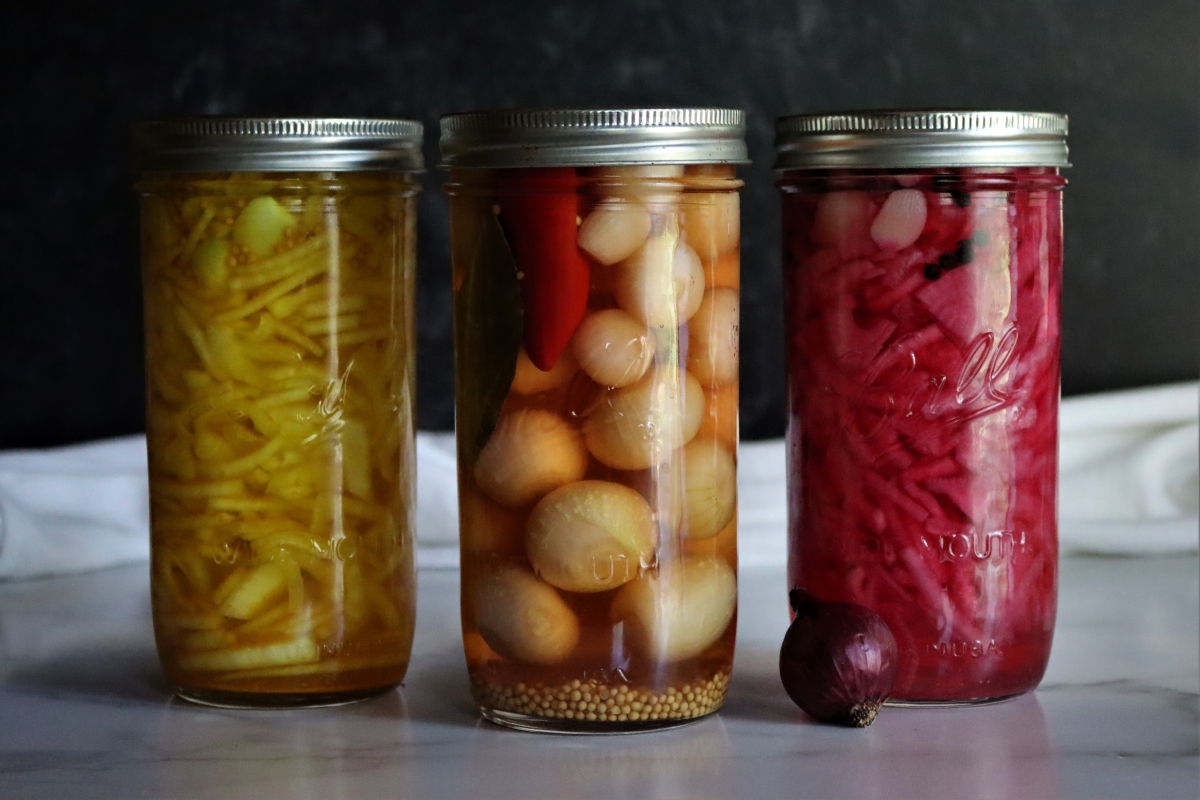
Pickled onions are a staple of fancy burger bars and upscale restaurants, adding zip to an otherwise everyday sandwich and balancing out the richness on a charcuterie plate. Believe it or not, they’re incredibly easy to make at home with just a few everyday pantry staples ingredients.
They’re incredibly versatile and can be made with all manner of seasonings to suit your tastes, provided you follow a few basic rules, ensuring there’s enough vinegar for a proper pickle.
I’ll take you through four different recipes for pickled onions, all of which are staples in my house.
- Classic Pickled Red Onions, which are as beautiful as they are tasty.
- Bread and Butter Pickled Onions, perfect for burgers and summer cookouts.
- Pickled Pearl Onions, for cocktails and charcuterie plates, these have a bit of heat.
- Lime Pickled Onions, made with fresh lime juice, perfect for complementing both Mexican and Indian dishes.
Each of these recipes can be made as quick refrigerator pickles, and all but the lime pickled onions are approved for home canning as well.
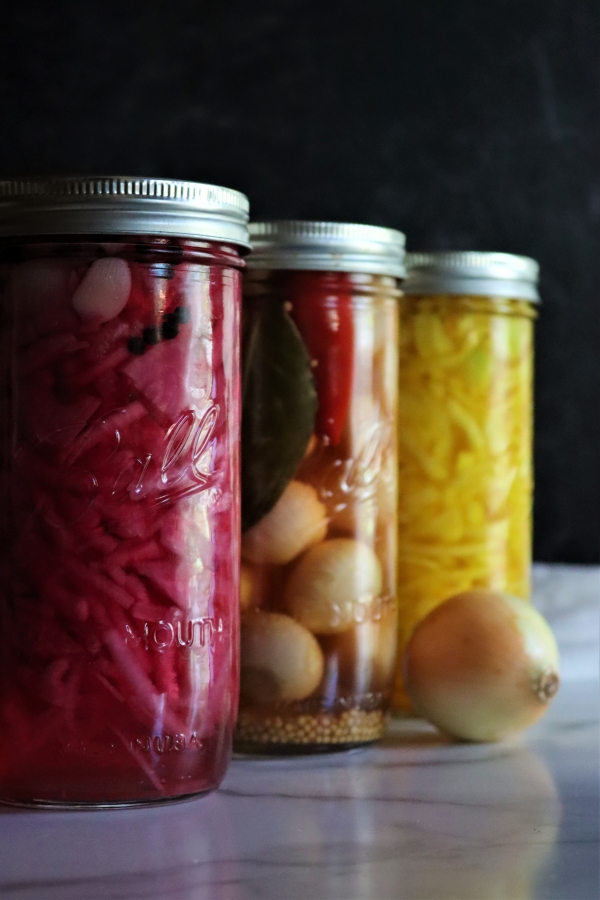
Pickled Onion Recipes
The success of homemade pickled onions largely depends on the brine. A basic pickling brine for making pickled onions contains vinegar, salt, sugar, and any spices you might want to add. There are some key ratios to keep in mind, but beyond that, there’s an incredible amount of flexibility in these pickled onion recipes.
To make a proper “pickle,” the brine must be at least half vinegar (5% acidity). The other half of the liquid is usually water, but it can be other flavorful liquids like wine or juice, or even just more vinegar for a bit more sour tang in the finished pickled onions.
The ratio you prefer is entirely based on personal preference, anywhere from 1 part vinegar to 1 part water, all the way up to just vinegar alone.
A brine made with a 1:1 ratio of vinegar to water is perfect for kids or anyone who doesn’t like their pickled onions too tangy. I love super-tangy pickles so I use more vinegar (for example, 1 1/2 cups of vinegar and 1/2 cup water).
You can also add ingredients like sliced jalapeño peppers, ginger, or horseradish to really kick the flavor up a notch. If you’re planning on canning your pickles, you’ll want to make sure you’re working with a brine that’s at least 50 percent vinegar.
You can also play around with the salt and sugar quantities. Some pickles, like my recipe for bread and butter pickled onions, call for more sugar. Don’t worry about too-sweet pickles, the sugar is mixed with undiluted white vinegar which keeps the pickles zippy and full of that signature bread and butter flavor.
A basic starter brine, which makes enough to fill one 1-quart jar or two 1-pint jars, looks like this:
- 1 cup white vinegar
- 1 cup water
- 2 Tbsp. salt
- 2 Tbsp. sugar
- A few teaspoons of spices (depending on the brine you’re making)
When making pickled onions, the brine is heated until very hot or boiling and then poured over the dry spices and chopped onions (or whole onions, if using pearl or pickling onions). At this point, the jars can be stored in the fridge as refrigerator pickles for a month or two, or they can be canned and stored as shelf-stable pickles.
Whether you make refrigerator pickles or canned pickles, give them at least 2 to 3 days to marinate before eating — the small wait is definitely worth it.
I’ve included three recipes for vinegar pickled onions, and one unique recipe for lime pickled onions that don’t follow the rules.
With the lime pickled onions, they’re ready in about an hour and are best consumed fresh. Don’t attempt to preserve lime pickled onions using the canning method, the fresh lime juice flavor is lost and the texture of the red onion rapidly becomes slimy.
Pickled Red Onions
These pickled onions are an old school standby; great for piling onto burgers, adding to a peppery arugula salad, or serving with grilled or roasted fish. Apple cider vinegar gives the pickles a mild fruity sweetness and helps blunt some of (but not all) the heat from the sliced red onions.
I like to give these pickled red onions as gifts when I make a batch; they have a wide enough range of culinary uses that they appeal to a large audience (not to mention, the pretty pink color is just so darn pretty).
To make a quart, start with 4 cups sliced red onions, then pack into the jar and pour boiling brine over the top. My brine includes:
- 1 1/2 cups apple cider vinegar
- 1/2 cup water
- 1/2 cup granulated sugar
- 1 Tbsp. pickling salt
- 1 tsp. mustard seed
- 1/2 tsp. celery seed
- 1/2 tsp. red pepper flakes
Adjust the spices/sugar/salt to your tastes, but make sure the brine is at least half vinegar.
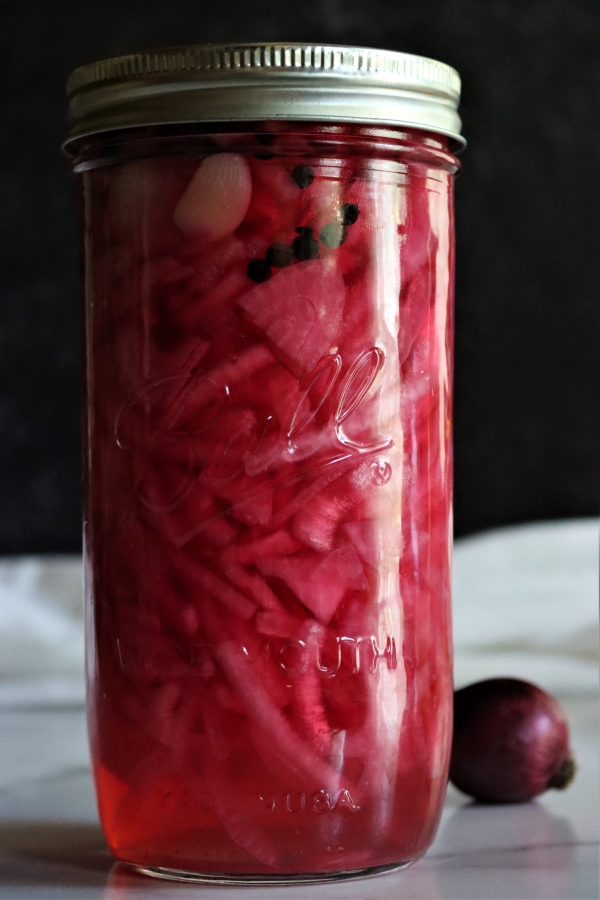
Bread and Butter Pickled Onions
You can use almost any type of old white or yellow onion in this recipe for bread and butter pickled onions, the turmeric-tinged brine transforms even the hottest onions into a sweet and tangy pickle. Unlike bread and butter pickled cucumbers, which tend to lose some of their crisp texture over time, these pickled onions stay crunchy indefinitely.
These pickled onions are immensely satisfying on burgers, roast beef sandwiches, and grilled sausages (preferably on a bun, for the full ballpark experience).
The brine for bread and butter pickled onions is almost the same as in my recipe for Bread and Butter Pickles. My recipe calls for a good bit of sugar, but the addition of undiluted vinegar and spices yields a perfectly tangy and not-too-sweet finished product.
Start with 4 cups of sliced white or yellow onions in a quart jar, and then pour boiling brine over the top, made from these ingredients:
- 2 cups white vinegar
- 1/2 cup granulated sugar
- 1 Tbsp. pickling or canning salt
- 1 Tbsp. mustard seeds
- 1/2 tsp. celery seed
- 1/2 tsp. ground turmeric
Some people like their bread and butter pickles sweeter than this, so feel free to increase the sugar if you like (or decrease it, either way).
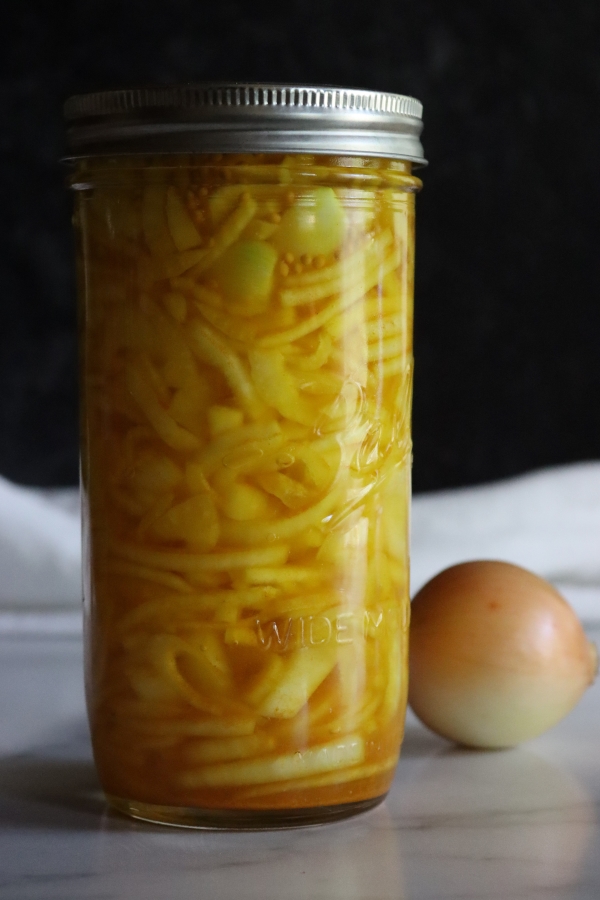
Pickled Pearl Onions
These pickled pearl onions are infused with heat from horseradish and spicy peppers. Despite their small size, they pack a punch in cocktails (try these onions the next time you’re in the mood for a Gibson) and a small bowl of pickled pearl onions is never remiss on a cheese and charcuterie platter.
This recipe calls for peeled pearl onions, but don’t let that deter you from trying this pickle recipe out for yourself.
The most efficient way to peel these tiny onions is to blanch them in a big pot of boiling water until the skins loosen (about 3 to 7 minutes). Drain the onions and plunge them into a bowl full of ice-cold water and let sit for a minute before draining and peeling — the skins should slip right off.
Note you’ll need a bit more brine to make pickled pearl onions, as they don’t pack as tightly in the jar as sliced onions. To make the bring, bring the following ingredients to a boil:
- 2 1/2 cups white vinegar
- 1/2 cup water
- 1/2 cup granulated sugar
- 1 tsp pickling or canning salt
- 1 tbsp mustard seeds
- 1 or 2 tsp. prepared horseradish
- 1 small red chili peppers, such as cayenne, sliced in half lengthwise
- 1 bay leaf
Feel free to skip any of the spices that don’t suit your tastes, though the heat from both the horseradish and the hot peppers really makes these special.
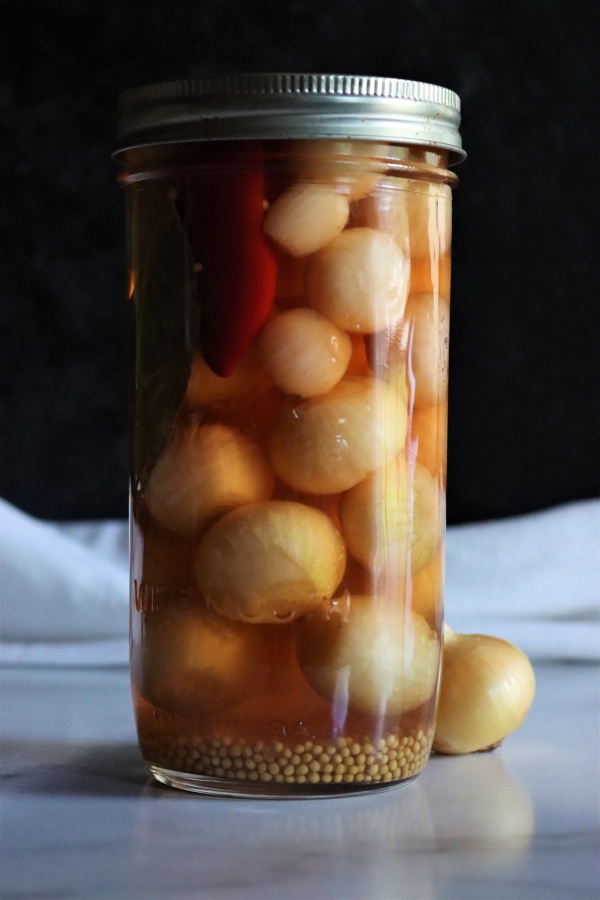
Lime-Pickled Onions
Undeniably magenta and unbelievably delicious, lime-pickled onions are made with only three ingredients: red onions, lime juice, and salt. I use these easy refrigerator pickles on everything (well, almost), but especially enjoy them when they’re piled onto a taco or a plate of pulled pork.
I don’t recommend canning lime-pickled onions, they’ll lose that fresh lime flavor and the texture will deteriorate quickly. Beyond that, there’s just not enough acidity or liquid in this recipe to can safely, so don’t try it. Make these fresh, and enjoy them for the bright citrus and savory onion flavors they add right out of the fridge.
This recipe yields a relatively small batch that can be stored in the fridge for 2 to 3 weeks.
For lime pickled onions, you’ll need:
- 4 cups red onion, sliced
- 6 Tbsp. lime juice (from around 3 limes)
- 1 tsp. salt
These are for quick refrigerator pickles only, not for home canning.
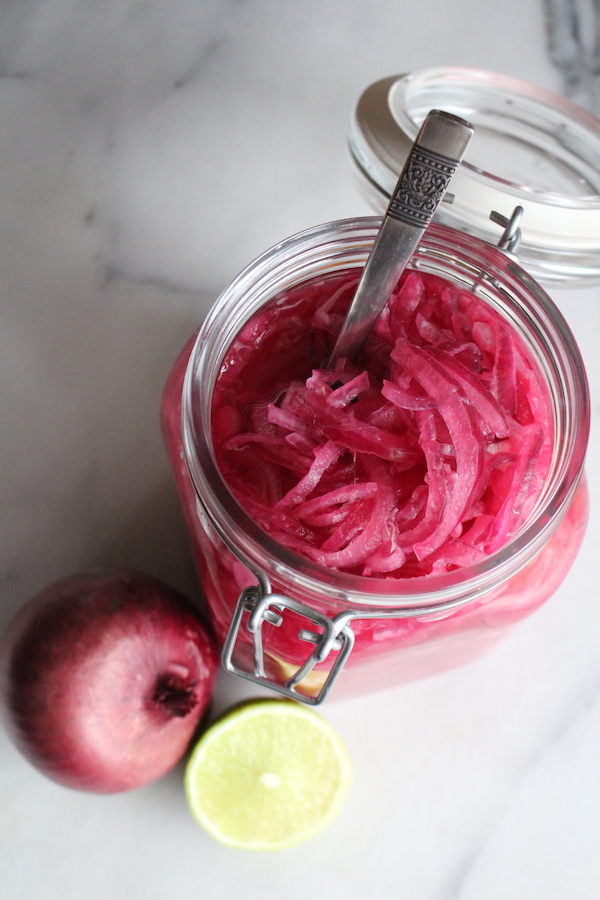
Canning Pickled Onions
Once you’ve mixed the onions, spices, and brine, you can store the pickles in the fridge (let the jar and its contents come to room temperature first). They won’t store at room temperature without canning, but they will keep in the refrigerator for a month or two.
Canning pickled onions allows you to make a big batch and store them in the pantry without refrigeration for 12 to 18 months.
If water bath canning is completely new to you, my Beginner’s Guide to Water Bath Canning is a great resource. You’ll find detailed instructions for raw pack (and hot pack) canning, as well as tips and troubleshooting for anything canning-related that might come your way while you prepare your pickled onions.
These pickled onions are made using the raw pack canning method, which means the raw onion and other vegetables are added to the jar before being covered with hot brine, leaving a 1/2 inch of headspace between the underside of the lid and the top of the brine or food.
Prepare a water bath canner along with canning lids and rings. Since this is a raw pack pickled onion recipe, the canner water should be around 140 degrees F when the jars go in.
Pack the dry spices, onions, and other vegetables into the jars, leaving a 1/2 inch headspace at the top. Pour boiling brine over the top and seal with 2-part canning lids to finger tight. Process in a water bath canner for 10 minutes for pints, 15 minutes for quarts. For higher elevations, process for 15 minutes for pints (20 for quarts) at 1,000 to 6,000 feet or 20 minutes over 6,000 feet (25 for quarts).
As I mentioned before, these pickled onion recipes are made using the raw pack canning method. This means that the water in the water bath canner should be 140 degrees F when the jars are added (hot enough to burn your hand, but nowhere near the simmering or boiling point). This helps to prevent thermal shock and ensure an even temperature during the relatively short canning time. The water is then heated to a rolling boil.
The timer starts when the canner comes to a full rolling boil.
When the timer goes off, turn off the heat but let the jars sit in the hot water for another 5 minutes, at which point they can be carefully removed from the canner and allowed to cool at room temperature. Any unsealed jars should be kept in the fridge and eaten within a couple of weeks.
Pickled onions will maintain peak quality on the pantry shelf for 12 to 18 months if properly sealed, and be technically good to eat for much longer, but they’ll begin to degrade in quality after about 12 to 18 months.
(Reminder, this technique is only for the vinegar pickled onions, but is not safe for the lime pickled onions.)
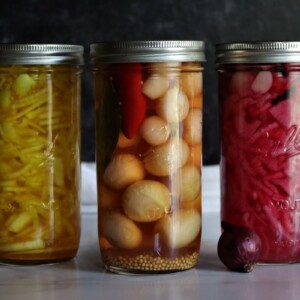
Pickled Onions
Ingredients
Pickled Red Onions
- 4 cups red onions, trimmed and thinly sliced (about 2 pounds as purchased)
- 1 1/2 cups apple cider vinegar
- 1/2 cup water
- 1/2 cup Sugar
- 1 Tbsp. pickling salt
- 1 tsp. mustard seed
- 1/2 tsp. celery seed
- 1/2 tsp. red pepper flakes
Bread and butter pickled onions
- 4 cups thinly sliced onions, white or yellow
- 2 cup white vinegar
- 1/2 cups Sugar
- 1 Tbsp. pickling or canning salt
- 1 Tbsp. mustard seeds
- 1/2 tsp. celery seed
- 1/2 tsp. ground turmeric
Pickled pearl onions
- 4 cups pearl onions, peeled**
- 2 1/2 cups white vinegar
- 1/2 cup water
- 1/2 cup Sugar
- 1 tsp pickling or canning salt
- 1 tbsp mustard seeds
- 1 or 2 tsp. prepared horseradish
- 1 small red chili peppers, such as cayenne, sliced in half lengthwise
- 1 bay leaf
Lime-pickled red onions*
- 4 cups red onion, sliced
- 6 Tbsp. Lime Juice, from around 3 limes
- 1 tsp. salt
Instructions
- 1. Add dry whole spices to the bottom of a 1-quart jar.
- 2. Fill jar with sliced raw onion or whole pearl or pickling onions, adding any other vegetables called for in the recipe at this stage as well. Leave 1/2 inch headspace at the top of the jar.
- 3. In a stainless steel saucepan, combine vinegar, water, sugar, salt, and ground spices. Bring to a simmer, stirring to dissolve.
- 4. Pour the hot brine over onions (again, leaving 1/2 inch headspace between the brine and the lid).
- 5. Seal the jar with a lid and refrigerate.
Notes
Easy Pickle Recipes
Looking for more easy pickle recipes?
- Dill Pickle Recipe for Canning
- Pickled Peppers
- Sweet Dill Pickle Relish
- Pickled Golden Beets
- Homemade Gherkins (Baby Cucumber Pickles)
- Pickled Eggs (Not for Canning)
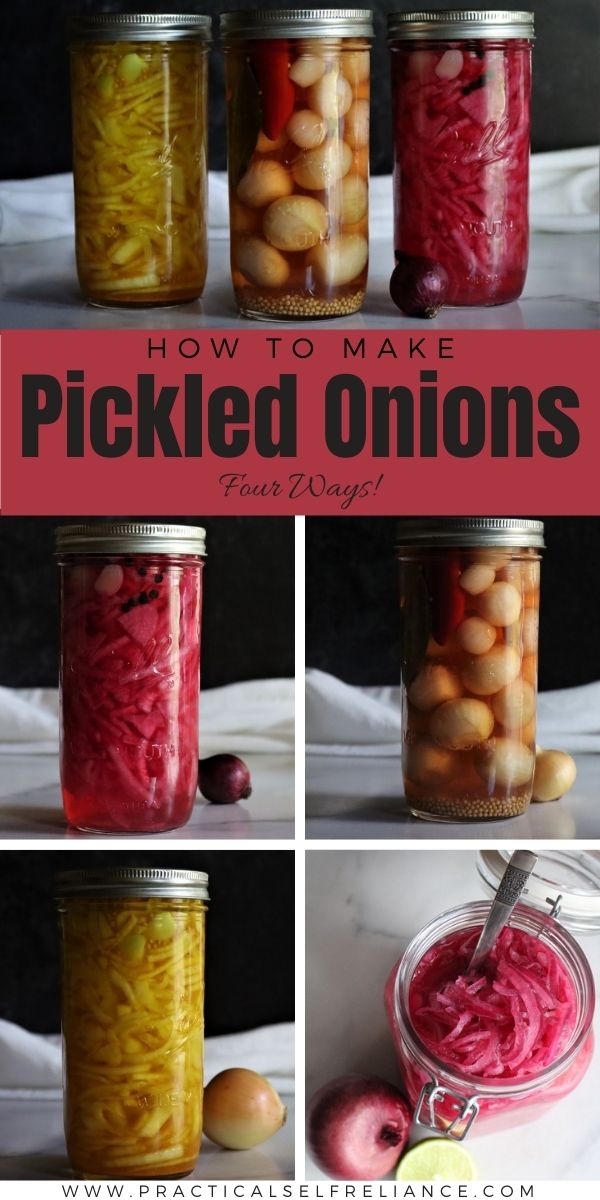
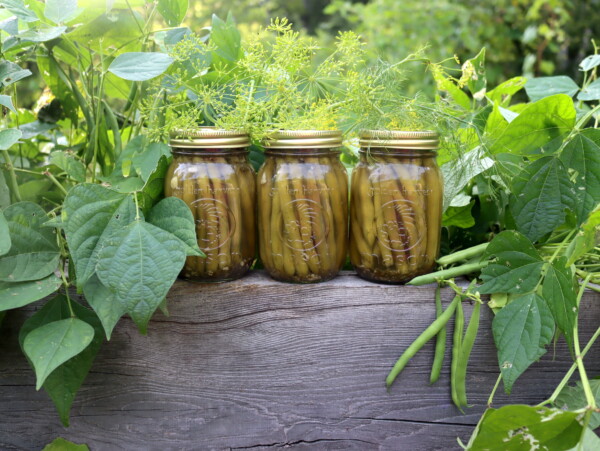
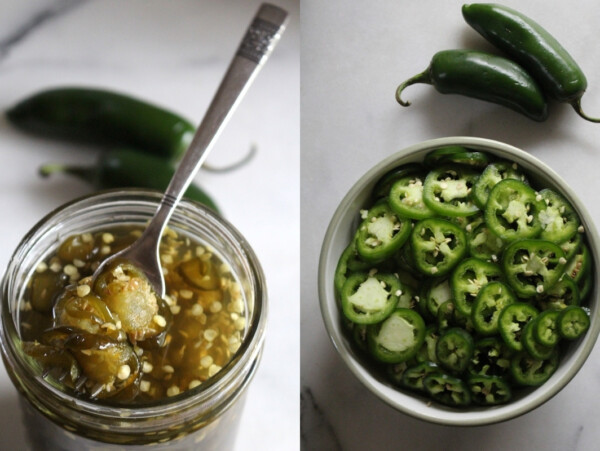












Hi! I can’t find the source for processing times, method, recipe acidity and safety testing noted anywhere. I just want to comfirm that this has been taken from a known tested recipe before I make it as I’m unable to trace it back myself.
The canning times and vinegar proportions come from the National Center for Home Food Preservation. In pickling recipes for vegetables, generally you’re looking for at lest 50% vinegar at 5% acidity for safe preservation. These recipes are well beyond that. Enjoy!
Hi. I just canned a batch of pickled onions that called for 5 1/2 cups of vinegar, 1 cup of water, 2 cups sugar, and 2 tsp salt. I’m now wondering if I added that last 1/2 cup of vinegar. Is this still safe, or does the sugar dilute the acidity in the brine? are you talking strictly about the vinegar and the water at least 2 parts vinegar to 1 part water, or does that include the sugar and salt being part of that ratio?
The vinegar and water ratio is what is important for the safety aspect of the recipe.
Great! I figured it was fine, after much research, thanks for replying!
Hello, I tried one of the pickled onion recipes and I’m sure to want to make it again. Can I re-use the left-over brine for the next batch?
Is this excess brine that wasn’t used in the first batch or is it the leftover brine that the onions were in?
Brine the onions were preserved in
As long as you are keeping them in the refrigerator and not canning them, you should be able to reuse the brine without issues. Canning is a different story though because you can’t be sure of the acidity level after it has already been processed with the vegetables in it. If your brine starts to look really cloudy or starts to smell off it’s probably time to replace it.
Interesting recipes. I’ve found that for pickling pearl onions that malt vinegar works the best. I’ve had good success using this recipe:
https://www.daringgourmet.com/english-pickled-onions-pub-style/
That’s great! Thanks for sharing.
My dad used to make pickled onions, and boy, were they good! I don’t know that he used sugar. Is it necessary, or can I make them without the sugar…or use something like stevia? Thanks for any insight.
The sugar is not there for preservation but for flavor. You can leave it out or substitute if you wish.
Your blog is a great source of inspiration and information. I can’t wait to try these recipes !